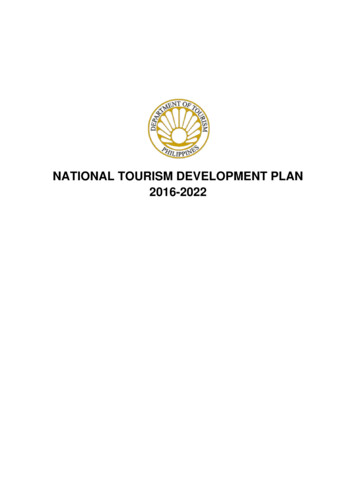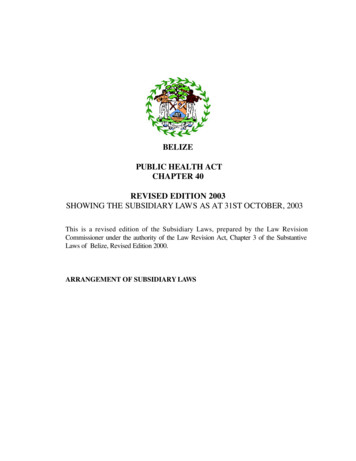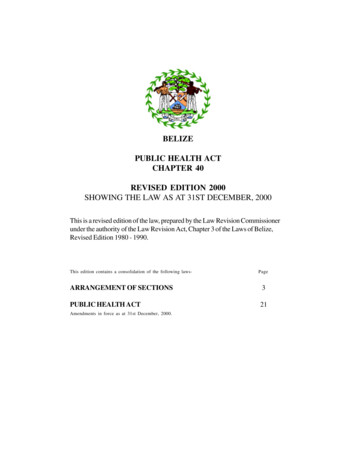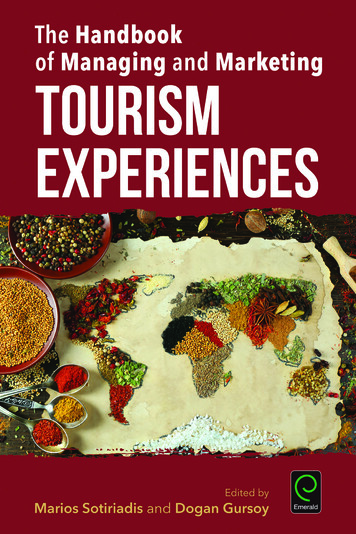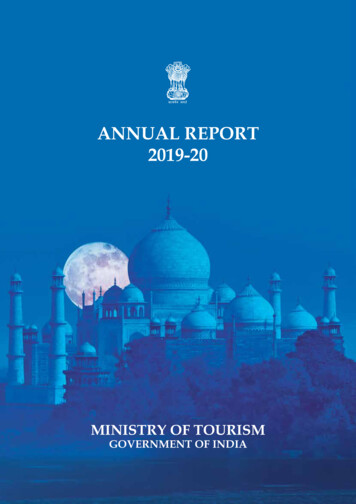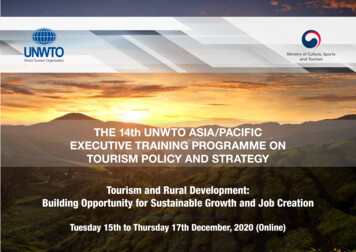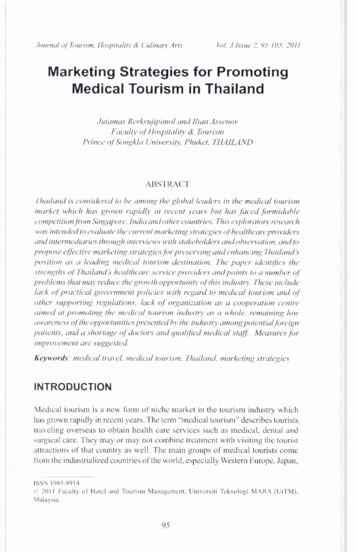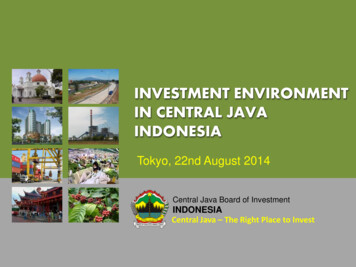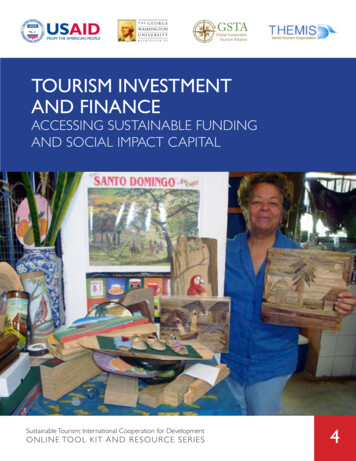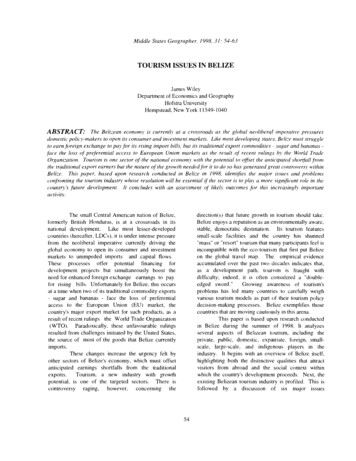
Transcription
Middle States Geographer, 1998,31: 54-63TOURISM ISSUES IN BELIZEJames WileyDepartment of Economics and GeographyHofstra UniversityHempstead, New York 11549-1040ABSTRACT: The Bek,ean economv is currentlY at a crossroads as the glohal neoliheral imperative pressuresdomestic policy-makers to open its consumer and investment markets. Like most developing states. Beli:.e must struggleto earn foreign exchange to pay for its rising import hills, but its traditional export commodities - sugar and hananas face the loss of preferential access to European Union markets as the result of recent rulings hy the World TradeOrgani:.ation. Tourism is one sector of the national economy with the potential to offset the anticipated shortfall fromthe traditional export earners but the nature of the growth needed for it to do so has generated great colltroversy withinBelize. This paper, based upon research conducted in Belize in 1998, identifies the major issues and prohlemsconfronting the tourism industry whose resolution will be essential if the sector is to playa more significant role in thecountry's future development, It concludes with an assessment of likely outcomes j(Jr this increasingly importantaetivi"'.The small Central American nation of Belize,formerly British Honduras, is at a crossroads in itsnational development. Like most lesser-developedcountries (hereafter, LDCs), it is under intense pressurefrom the neoliberal imperative currently driving theglobal economy to open its consumer and investmentmarkets to unimpeded imports and capital flows.These processes offer potential financing fordevelopment projects but simultaneously boost theneed for enhanced foreign exchange earnings to payfor rising bills. Unfortunately for Belize, this occursat a time when two of its traditional commodity exports- sugar and bananas - face the loss of preferentialaccess to the European Union (EU) market, thecountry's major export market for such products, as aresult of recent rulings the World Trade Organization(WTO). Paradoxically, these unfavourable rulingsresulted from challenges initiated by the United States,the source of most of the goods that Belize currentlyimports.These changes increase the urgency felt byother sectors of Belize's economy, which must offsetanticipated earnings shortfalls from the traditionalexports,Tourism, a new industry with growthpotential, is one of the targeted sectors. There iscontroversy ragIng,however,concerningthedirection(s) that future growth in tourism should take.Belize enjoys a reputation as an environmentally aware,stable, democratic destination, Its tourism featuressmall-scale facilities and the country has shunned"mass" or "resort" tourism that many participants feel isincompatible with the eco-tourism that first put Belizeon the global travel map. The empirical evidenceaccumulated over the past two decades indicates that,as a development path, tOUrIsm is fraught withdifficulty; indeed, it is often considered a "double edged sword,"Growing awareness of tourism'sproblems has led many countries to carefully weighvarious tourism models as part of their tourism policydecision-making processes. Belize exempli lies thosecountries that are moving cautiously in this arena.This paper is based upon research conductedin Belize during the summer of 1998. It analyzesseveral aspects of Belizean tourism, including theprivate, public, domestic. expatriate, foreign, small scale, large-scale, and indigenous players in theindustry. It begins with an overview of Belize itself,highlighting both the distinctive qualities that attractvisitors from abroad and the social context withinwhich the country's development proceeds. Next, theexisting Belizean tourism industry is profiled. This isfollowed by a discussion of six major issues54
Tourism Issues in Belizedominant. though representing just 30% of the 1991population. They are descendants of the labour forceimported by the British to work in timber extractionand on the first plantations. They are concentrated inBelize district, especially in Belize City, where theyconstitute 70o/c of the population (Barry and Vernon,1995; p. 69). Spanish-speaking mestizos represented40% of the 1991 population and dominate the northernOrange Walk and Corozal districts and the westernCayo district. Many are descended from refugees whofled Mexico's War of the Castes in the mid-1800s.Other significant groups include the Garffuna, alsoknown as Black Caribs, three distinct Mayan societies,German Mennonites, and smaller numbers of Chinese,Indians, Europeans, Lebanese, and North Americans.As English is the language of Belize's educationsystem, all longer-term residents arc fluent in thelanguage regardless of what they speak at home, anasset to the country's tourism aspirations. Such multi ethnicity yields a rich cultural mix; it also engendersthe possibility of social tensions, especially where theethnic balance is shifting. Belize received severalthousand refugees during the 1980s from war-tornGuatemala and El Salvador, and subsequent labourmigrations came from those countries and Honduras.Animosity between Creoles and mestizos rose as thelatter increased numerically, diminishing the country'sCaribbean identity. Such tensions have not resulted inwidespread violence but they are of great concern tothe government and to the tourism sector, whose well being depends upon the country's traditional stability.So long as tranquility reigns, however, Belize's mixedidentity can be marketed in positive ways to attractvisitors who seek a Latin American experience In anEnglish-speaking setting.confronting the industry as it prepares to assume aThe paperlarger role in the national economy.concludes with an assessment of likely outcomes asBelize pursucs JC\c!()pll1cnt within global and regionalframeworks that move it into growing competition fortourism markets with other LDCs responding to similareconomic imperatives.BELIZE: CENTRAL AMERICA ORCARIBBEAN?Belize (Figure I) is a small country with alarge identity crisis. Though situated on the CentralAmerican isthmus, it faces the Caribbean Sea andshares a colonial past with many insular Caribbeanstates and Guyana. It is officially English-speaking,unlike its mainland neighbours, the result of twocenturies of British rule. Smaller than all CentralAmerican states except EI Salvador. it is significantlylarger than Jamaica, Puerto Rico, and the LesserAntilles, increasing its physical geographic diversityand tourism potential. In the 1990s, the countryparticipates in the affairs of both regions, as a memberof Caribbean Community and observer to the CentralAmerican Common Market, suggesting a possiblefuture role as a "bridge" between the two.The country's small population is a distinctivefeature. The 1991 census counted 189,000 inhabitants;estimates for 1998 range up to 240,000, at a density offewer than 30 people per square mile. One third of thepeople are concentrated in greater Belize City, leavingvast tracts of sparsely settled land, appealing toecotourists but rendering the country more vulnerable,particularly to Guatemala, whose claim to Belize datesback to the colonial period. Population size limits thetax base and finances available for the infrastructuredevelopment needed to boost the tourism sector. Thisis reflected in the dearth of paved roadways, especiallyin the half of Belize lying to the south of the east-westBelize City- Belmopan-San Ignacio axis (Figure I). Asa result, the country must rely upon foreign donors tofinance improvements in its transportation system.Despite its small population, Belize ISethnically and racially diverse, adding to its tourismappeal. Creole-speaking Afro-Belizeans are politicallyBELIZE'S TOURISM INDUSTRYA profl1e of a country's tourism industrycustomarily includes data on the numbers and sourcesof visitors, their arrival points and destinations withinthe country, their spending characteristics, length ofstay, and the activities in which they are engagedduringtheirtrips.It alsofocusesonemployment,tourism infrastructure, particularly in the55
Middle States Geographer. 1998.31: 54-63Belize" CorozalMexico\\\,\,,,- .,,' i,-- --IIIOrange WalkI/\, iIBelizeII.,,,I,' -----,CityI , XunantunichRuins0\Belmopan eo.,'San IgnacIo I ------ .,J:iJ- .:.:.::: ".:'. . . SQJ :::.}.: "G.i . .'\i.G . . .: /. .'.Pine Ridge/v '" .::I·fl·. ·.: \":. Coral Reefs BeIiZ IIII-Ambergris: : Cav.:' San PedroJ-)StannCa::;:u; ::-, reek -[:1o1-//'- OledOII50 km100CentralAmericaPunta GordaFigure 1: Belize (courtesy of Dr. I-P. Rodrigue)56
Tourism Issues in Belizeare the only months with hotel occupancy rates ahove30%. February and March are busiest. but even then,occupancy seldom tops 40% (BTB 1998, Table 2.6).May through October are the slowest months, withIn general, hoteloccupancy rates below 25t.7c.occupancy has remained low.Despite this,construction of new facilities has continued. Both thenumber of hotels and the number of beds have doubledsince 1988, possibly offsetting rises in the rate ofoccupancy during that period.Once in Belize. tourists have many optionsavailable. The country offers a variety of cultural andphysical attractions.including several Mayanarchaeological sites and the world's second longestbarrier reef. Its mountains and rainforests. many setaside In parks and reserves, appeal to eco-tourists.including many birders.Belize's cultural mix,especially the Garifuna and contemporary Mayangroups, attracts other visitors.These sites aregeographically dispersed, but the country's size makesit possible to see many of Ihem as day-trips from acentralized base. This has led to the rise of three Ambergris Caye (on the barrier reet), the SanIgnacio area (western Cayo district). and Belize City.Accommodations can be found elsewhere, including onsmaller cayes and in coastal towns, but are fewer innumber.The spatial concentration of theaccommodation sector increases the demand fortransportation, leading to employment opportunities formany van/taxi drivers. Most also serve as tour guides,for which they are certified through training programsoffered by the BTB (DuPlooy, 1998).The hospitality sector in Belize differssubstantially from that found elsewhere in theCaribbean region. The number of beds - 6425 in 1997(BTB, 1998, Table 2.3a) - places it among medium sized destinations such as the US Virgin Islands, butnearly 92% of its 383 hotels are small, with 20 or fewerrooms. Only six have more than 50 rooms, all of themin Belize City and Ambergris Caye (BTB, 1998, Table2.3b). This profile suggests a limited presence ofmajor international chains; in fact, the ownershippattern includes non-resident foreigners as owners ofthe few larger properties and some medium-sizedhotels; resident expatriate owners of medium-sizedproperties, especially eco-Iodges; and Belizeannationals as small-to-medium-scale property owners.hospitality sector, where occupancy rates andseasonality arc of great concern. Space limitationspreclude development of an exhaustive profile here;what follow Ol!l:l :.J hnef overview of Belize's tourismindustry and insights to the discussions of specificissues that follow.Data collected on tourist visitations ISproblematic in many countries and Belize is noexception. Prior to 1991, border commuters - peopleworking in Belize but living in adjacent regions ofGuatemala and Mexico - were tabulated as touristarrivals, making analysis of tourism's size and growthmore difficult.Beginning in 1991, a change inclassification methods made it possible to distinguishtourist and cruiseship visitors from other arrivals.Visitations increased from 77 ,970 in )991 to 136,967in 1997. Growth has been inconsistent. however, withdeclines registered in 1995 and 1996 (BTB, 1998).Unfortunately, Belize does not separate tourists fromother arrivals when tabulating source areas of itsvisitors, making it difficult to ascertain its majortourism markets. One must rely upon the regularsurveys of tourists conducted by the Belize TourismBoard (BTB); these provide a clear indication that thecountry is heavily dependent upon the US market,source of 63% of all respondents, followed by Europeand Canada, with 23% and 7%, respectively (BTB.1998; Section 4, p. 3). Given this concentration,diversifying source areas should become a high priorityfor the country's tourism planning. The potential payoffof such a strategy seems obvious given that currentvisitors remain in the country an average of 7.1 dayswhile spending an average of US I 00 per day (BTB,1998, Section 4, pp 3-5). Canadian visitors stay thelongest, an average of 8.5 days.The great majority (64%) of foreign visitorsin 1997 entered the country through Belize City'sinternational airport; fewer than 2% arrived oncruiseships. Most of the others (27%) entered Belizeby land, from Mexico's Yucatan Peninsula in the northor Guatemala's Peten region in the west. Another 4.7%entered the southern port of Punta Gorda by ferry fromGuatemala or Honduras (BTB, 1998, Table A). Thisindicates that many tourists now include Belize onmulti-nation itineraries, a trend its tourism policymakers would like to expand. There is a pronouncedseasonality to tourism in Belize. Visitation is highestduring the winter months and December through March57
Middle States Geographer, 1998,31: 54-63The latter were prevalent during the initial stage ofBelizean tourism in the 1960s but their importance hasdeclined since. Many have sold out to foreigners whobenefited lrum favourable government policiesoriented to attracting foreign capital.With a diverse economy based uponagriculture and services. Belize is less dependent upontourism for job creation than many of its Caribbeanneighbours. Nevertheless. the sector is still importantto a labour force of 71,000 (1997), with approximately4000 working directly in tourism and another 9000indirectly employed in the industry (Ramnarace, 1998).Unemployment hovers around 12% (1997) for thenation overall, making additional employmentopportunities welcome, particularly in view ofanticipated job losses in sugar production.The lack of paved roads in the southerndistricts of Stann Creek and Toledo retards theirtourism development efforts. Though matters haveimproved during the last decade, the "SouthernHighway" remains their only road link to the rest ofBelize. It is a dirt road with narrow wooden plankbridges crossing rivers and streams. A paving projectis now in progress; until its completion, the south willendure relative isolation that places it off the path ofmost foreign visitors. Other transportation optionsinclude scheduled air and ferry service. Many remotecommunities are linked to Belize City by smallpropellor planes that land on narrow, often unpavedairstrips. Coastal and insular settlements are served byprivate "ferries," in reality, large uncovered speedboats.These options may differ from what many tourists mayexpect or hope for, though they add to the charm of theBelizean experience. For independent travelers, amarket the country seeks to attract, these alternativesare economical and appeal ling.contribution to future national development. Thenumber of issues involved is greater than can receivetreatment here; instead. a selection of six challenges ispresented for analysis. First, the direction for theindustry is critical. as various kinds of tourism are seenas incompatible with others.Belize must choosewhether to pursue "mass tourism" with its large resortsand cruiseship calls or to continue emphasizing eco tourism and other special-interest tourism. Second,institutionalizationof theindustry must bereconsidered, a problem frequently encountered inLDCs. The roles of public, private, and parastatalorganizations must be defined and linkages amongthem improved. Third, the issue of tourism's dispersionthroughout the country should be reviewed. Mostactivity is now found in just two of the nation's districts,Belize and Cayo, but tourist attractions exist in all six.Fourth, Belize's geopolitical situation will affect itstourism development as the country hopes to increasethe share of tourists including Belize on multi-countryMundo Maya itineraries. Fifth. recent activism byBelize's indigenous population. 10% of the nationaltotal, is generating native land claims, the success ofwhich will affect tourism, particularly in Toledodistrict. Finally, effective marketing is essential ifBelize is to boost its low occupancy rates, generateforeign exchange, and create employment. It venturesinto this realm at a time when many other LDCs facesimilar imperatives to do so, yielding a verycompetitive climate that requires Belize to clearlydistinguish its offering from those of numerous othertropical destinations.Belize has little choice but to confront all ofthese matters simultaneously. This necessitates a well coordinated, comprehensive plan. This process hasalready begun. The Ministry of Tourism and theEnvironment engaged a consulting firm to studyBelize's tourism industry and make recommendationsfor future strategies with regard to its development.These outside consultants, at the very least, haveprovided a basis for discussion of many of theimportant issues to be considered by the various publicand private entities involved in the industry.ISSUES CONFRONTING BELIZEANTOURISMToday, Belize faces major challenges as itattempts to invigorate its tourism industry to overcomethe anticipated earnings shortfall from its traditionalexport commodities. Each challenge, though, presentsopportunities to plan the growth of the industry in aneffective, sustainable manner to increase itsSpecial Interest versus Mass TourismThe direction of Belizean tourism underliesvirtually all of the other decisions the country must58
Tourism Issues inmake concerning the industry. Since its inception,Belize has relied on SCUBA diving and eco-tourism asthe pillars upon which the rest of the industry wasconstructed. I I d \ C Jcr seeking those fonns of tourismgenerally prefer small-scale settings that enable them topeacefully enJoy the natural attractions they have cometo see.They often fall into the category of"independent travelers" who shun package deals andrely upon travel agents for reservations but do theirown research on possible destinations.Most ofBelize's tourism infrastructure was designed toaccommodate such guests, as the hotel data aboveimplies. Even the largest concentration of tourismdevelopment in the country - Ambergris Caye - retainsits dirt roads and enforces a three-story limit onconstruction to maintain the sense of intimacy uponwhich its reputation has been based."Mass tourism" is rather different. Large scale resorts and cruiseships often are owned hyforeign corporations, frequently having links to thetransport sector to create the easily marketed travelpackages that Belize currently lacks. Travelers in thissector are often more concerned about the nature of thefacilities than with the specifics of the destination.Indeed, all-inclusive resorts fitting into this categoryremove any necessity for interacting with the hostsociety by providing all lodging, meals, entertainment.and activities on the resort property. Cruiseships satisfyall basic needs; passengers generally leave the shipsonly to shop or for day-trip activities. The travel agentsrelied upon by such travelers are encouraged toparticipate in "familiarization tours" so that they canmore effectively promote the hotel or ship involved.There is considerable tension between thesetwo forms of tourism in other Caribbean states (seeWiley, 1996). The presence of "mass tourists" interritorially small locations has made it difficult for theregion to attract environmentally-oriented travelers.despite considerable eco-tourism potential. The growthof ceo-tourism appears as a priority in developmentplans in many Caribbean countries (Dominica,Grenada, St. Kitts-Nevis, Curacao), even in theBahamas, well-known for mass-tourism, thoughofficials privately express recognition of the challengesthey face in achieving that goal. But Belize already hasan established eco-tourism industry. It must decidewhether it wishes to further develop that sector, branchThere isout in a new direction, or do both.Beli econsiderable opposition to choosing the latter twopaths, primarily emanating from the sizeable numher orsmall-scale operators in the country's traditionaltourism sectors. They argue that the two fomls oftourism are incompatihle and that Belize risks losing itslong-term base clientele if it pursues mass tourism.These tensions are politicized by puhlic sector policiesincreasingly oriented toward easing the conditionsunder which investment capital flows into the country,facilitating infrastructural development in the masstourism sector despite official rhetoric that contmues toadvocate eco-tourism. Such confusing signals fromBelmopan, the national capital. increase the anxicty ofproprietors in the eco-tourism sector. stimulating manyto become active in the Belize Tourism IndustryAssociation (BTIA), the major private sectororganization involved with Belizean tourism, as below.Tourism Institutionalization in BelizeResearchers who focus upon developingcountries frequently encounter issues related to theneed to strengthen institutional capabilities.Onelegacy of colonialism has heen its notoriousinattentiveness to developing strong institutionscapable of serving national needs in the post independence period.Like many LDCs, Belizeexemplifies this situation. and it applies to the country'stourism industry where just three major institutions canbe identified. These include the Ministry of Tourismand Environment, the Belize Tourism Board (BTB),and the above-mentioned BTIA.The Ministry of Tourism and Environment isthe major public sector entity involved.Itsresponsibilities include policy development andimplementation. and research on matters of concern totourism in Belize. The linkage between tourism andenvironment is unusual. dating only to 1989 (Pat, 1998)manifesting the high priority afforded to eco-tourism.Ministry officials and documents acknowledge thedependence of a strong eco-tourism industry upon ahealthy environment and one emerges from theiroffices with a sense that the future of eco-tourism inBelize is secure. This is not necessarily the case, as theministry lacks the power of other divisions of thegovernment, particularly the Ministry of Finance,which is responsible for economic planning. The lattermust contend with broader Issues of national59
Middle States Geographer, J 998, 3 J: 54-63development within the current neoliberal globalclimate and will therefore play an important role indetermining tourism policy in Belize.Thc,clond Institution of note is the BelizeTourism Board (BTB), a parastatal agency based inBelize City whose primary function is tourismpromotion. It also acts as liaison between the publicand private sectors and with regional associations likeInthe Caribbean Tourism Organization (CTO).addition, it conducts research on the industry andserves as an information center for drop-in tourists.Finally, the BTIA, an umbrella organizationfor private sector interests, operates at national anddistrict levels, with subgroups in all six of the country'sdistricts. It officially opposes any move toward masstourism (DuPlooy, 1998). It faces the challenge ofkeeping its constituent groups, including large-scaleand small-scale hoteliers, guest house owners, teurs, and naturalists, actively involved in theassociations activities. These groups do not often seethemselves as sharing common goals and interests.There was evidence that this had begun to change bythe summer of 1998, due in part to the hiring of a full time director for its General Secretariat in 1997provided a degree of professionalism and continuity toan operation that previously functioned through theefforts of volunteers. The change was also precipitatedby the emergence of an issue that galvanized concernamong BTIA members. The issue involved a proposalto redevelop an historic section of Belize City into amulti-block shopping area and cruiseship pier, similarto those now found on several Caribbean islands. Theplan calls for razing several of the city's finest Victorianstructures, including the headquarters of the BelizeAudubon Society (BAS), which IS leading theopposition to the project. The BAS manages six of thecountry's national parks and spearheads Belize'senvironmental education program. Consulted regularlyby the eco-tourism sector, it is concerned about theimpact of increased cruiseship traffic on the country'sbarrier reef, which offers few access points for largeships. The BTIA passed the "Caracol Declaration" in1998, calling successfully upon the government to haltplans for the project until it can be reconsidered(Nightingale, 1998).As Belize is a small country, the peopleinvolved in these organizations often know one anotheron a personal basis. The potential exists for greatercoordination. The imminent need to ascertain thefuture direction of Belizean tourism clearly provides anopportunity and rationale for achieving higher levels ofcooperation.Geographic Dispersion of the Tourism IndustryOnly two of Belize's six districts now benefitsignificantly from tourism. Belize district, centrallylocated, includes the country's premier entrepot, severaldiving destinations, and an array of ceo-tourism andcultural sites. It has the best road and boat networks inBelize, rendering its attractions more accessible. TheCayo district, in recent years. has become Belize'smajor eco-tourism destination. The interior Pine Ridgeregion is accessed through San Ignacio. the district'smajor town; many of the lodges that cater to foreigneco-tourists are found there. Cayo also contains oraffords access to several important Mayan sitesincluding Xunantunich and Caracol. The district iseasily reached by travelling the main cast-west roadthat links Belize City with the Guatemala border.If Belizean tourism is to fulfill its potentialand contribute to national development. planners mustpay more attention to the four districts largely bypassedby tourism. Despite the presence of many appeallingsites, accommodation and transport infrastructure lagbehind in those areas. The two southern districts,Toledo and Stann Creek. are the poorest in Belize andmerit special attention in national development plans.Completion of the Southern Highway will certainlyhelp but consideration should be given toward ensuringthat the real beneficiaries of that project arc the currentresidents of those districts. A concern voiced at theToledo district BTIA meeting in June 1998 was thatflows of multinational capital, facilitated by thehighway, would ultimately displace small. locally owned establishments that now dominate the region'stourism profile (Nightingale, 1998). According toKelvin Ramnarace, national BTIA director who waspresent at the meeting. such worries are not unique toToledo district. The two northern districts, OrangeWalk and Corozal. also remain marginalized withinBelizean tourism, though both have strong agriculturalsectors and are more prosperous than Toledo and StannCreek. This relative prosperity, however, is nowthreatened by the loss of protected sugar markets; thus,60
Tourism Issues ill Belizeincreasedinterest in developingindustries can be anticipated.theirtourismBelize's Contemporary Mayan PopulationGeopoliticallmpacb on Belizean TourismMaya culture is not just a relic: there are threeimportant Mayan groups living in Belize today, eachwith about 7000 people. The Yucatecan Maya ofnorthern Belize are descendants of people who flcdMexico's War of the Castes during the I840s. enteringBritish Honduras as refugees. The other groups, theMopan and Kekchi, live in the south, mostly in Toledodistrict. Their lineage includes the early inhabitants ofthe area and more recent arrivals from Guatemala;unlike the Yucatecan Maya, they live apart from otherBelizeans in agricultural settlements where they farmland leased from the government.The Mopan and Kekchi groups are currentlyengaged in two activities related to tourism. Oncinvolves filing a large land claim for a significant butsparsely settled portion of Toledo district.Representatives from Canadian "First Nations" whowon their own land claims have been consulting withthe Mopan and Kekchi. helping them prepare a claimto be filed in conjunction with a proposal to create alarge eco-park in southern Belize. If successful. thcclaim will be the first of its kind in Belize and will alterthe nature of development in Toledo. It exemplifies agrassroots, bottom-up movement aiming to reconcilecultural and environmental preservation with thcdevelopment needs of people. This effort merits futureresearch for its potential as a model for indigenousgroups in Belize and elsewherc.Also, the Toledo Eco-tourism Association(TEA) was established in the early I 990s byrepresentatives of several indigenous villages in thedistrict to raise the level of Maya participation inTEA philosophy emphasizes low-impacttourism.tourism that is both environmentally and culturallysensitive; it carries the additional aspect of trying tomaximize benefits to those communities that serve ashosts to the visitors. The result is an unusual model oftourism. Tourists arrange village visits while in PuntaGorda, the major town in Toledo (or have done so byphone or fax prior to arriving there). They use localbuses to go to the selected village where they stay inbasic guest lodges built in the Maya style by familiesparticipating in the program. The lodges have noelectricity or indoor plumbing but are very clean.Meals are taken with the families in their homes,Belize occupies a pivotal location in CentralAmerica's region wide tourism planning but its ability toparticipate in this process has been compromised by atenuous geopolitical sit
during the winter months and December through March . are the only months with hotel occupancy rates ahove 30%. February and March are busiest. but even then, occupancy seldom tops 40% (BTB 1998, Table 2.6). May through October are the slowest months, with occupancy rates below 25t.7c. In general, hotel occupancy has remained low.
